ANN ARBOR, Mich. — To coincide with our first go of it in the driver’s seat of the 2024 Chevrolet Silverado EV WT, Chevy dropped some good news in our laps. Just like its range figure took a leap from 400 to 450 miles last month, now its max towing and payload capacities have ameliorated. Instead of the previous 8,000 pounds of towing, the Silverado EV WT is now good for an even 10,000 pounds, while payload is up from 1,200 to 1,440 pounds.
Consequently, this Silverado EV WT offers far more range than any other electric pickup out there (not to mention almost every other available EV regardless of body style). The Rivian R1T comes in third at 328 miles (its 400-mile “Max Pack” battery is still AWOL), just behind the Hummer EV’s 329, while the Silverado’s most direct competitor, the Ford F-150 Lightning, gets up to 320 miles with the big battery option. That towing figure matches a Lightning equipped with the Extended Range Battery and Max Trailer Tow package. Ford still bests the Chevy in payload, at 2,235 pounds (or 1,952 pounds with the bigger battery).
But then there’s another figure that might come as a surprise, especially to early Silverado EV reservation-holders. This first version of the WT will start at $77,905, before destination. That’s considerably more than the $39,900 estimated starting price that’s that was listed on Chevy's reservation site until this week. But considering the price hikes to the F-150 Lightning, perhaps we shouldn’t be shocked (sorry). It’s still about $18,000 more than the Lightning Pro’s starting price, but that price includes just 230 miles of range and 5,000 pounds of towing (and the Pro is sold out for 2023). To get closer to Silverado capabilities, the Lightning XLT with the bigger battery and 10,000-pound towing options is in the Silverado EV’s ballpark, at $78,874 before destination. It’s a step up from Ford’s work truck trim, but it still falls 130 miles short of the Chevy’s range. You give and you take.still listed on Chevy’s reservation site
Chevy plans to launch a 350-mile version for about $5,000 less sometime this fall, with lower-priced models coming at some point in the future. Whether there’ll ever be that $40,000 version remains to be seen, but we’re not holding our breath.
But enough with the mental gymnastics. Let’s talk about this actual electric work truck. The EV isn’t at all a carbon copy of the internal-combustion Silverado. In fact, it’s a clean-sheet development, complete with its own look. While Ford’s Lightning is unmistakably an F-150, the Silverado EV looks a bit more like the Chevy Avalanche than its actual namesake. It’s not body-on-frame, (though Chevy won’t quite call it unibody, either) with its rigid Ultium battery pack structurally incorporated into its “body-frame-integral” construction. The cab and front seats are pushed forward toward the front axle, which opens up room for the second row of seating and makes it easier to see over the cowl. In its quest for ultimate driving range, Chevy paid close attention to aerodynamics. Hence the solid grille, as the EV only needs minimal airflow for thermal management. The sail panels (or “flying buttresses” as Chevy exterior design director Ryan Vaughn referred to them) do a lot to give this truck its unique look, but also reduce drag. A soft tonneau cover — standard equipment — also improves aero.
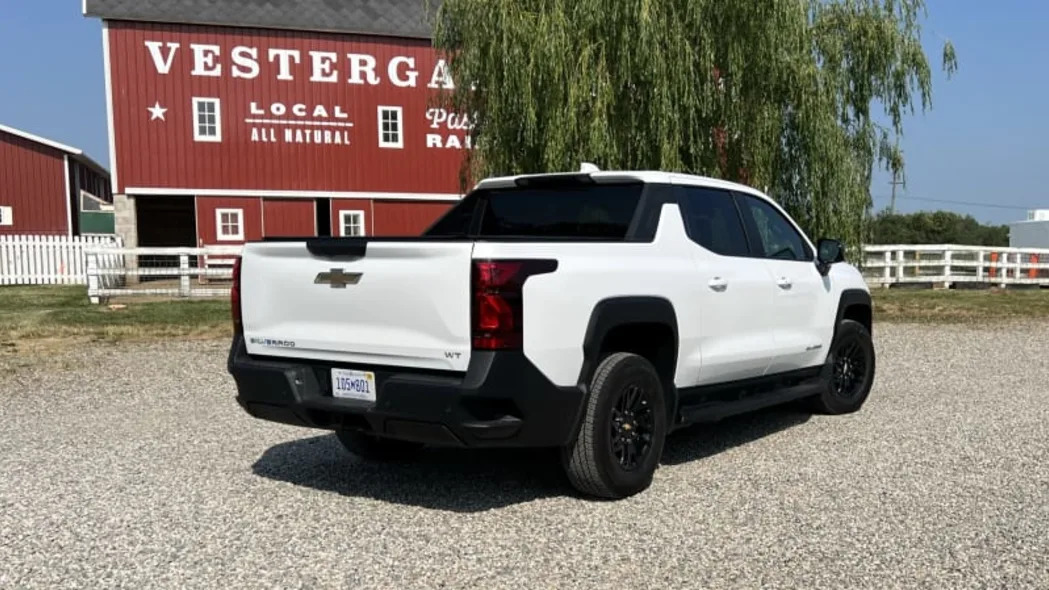

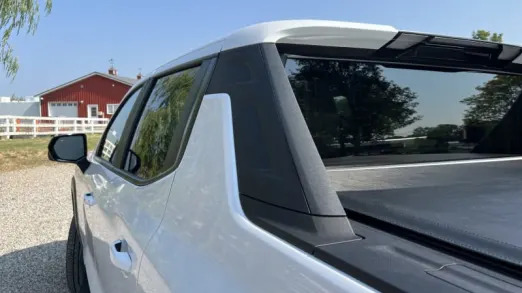
While the Silverado EV RST, which arrives later in the year, is shiny all over, the WT uses harder-wearing materials more suitable to rugged work environments. It’s also only available in white — great for government duty — though we imagine many fleets will add their own wraps, decals and color schemes. The glossy black wheels are a nice contrast, and complement the black plastic cladding and accents throughout the exterior. Oh, and there’s no midgate in the WT, as useful as that might be for hauling big cargo. The bed comes in one size — 5 feet, 11 inches — and there’s also extra storage space in the front trunk (with a 120-volt socket inside), though it’s a few cubic feet smaller than the Lightning’s.
There is one 240-volt and multiple 120-volt outlets in the bed that can draw power from the battery at a work site (or campsite, or tailgate party). The truck comes standard with 7 outlets and 7.2 kilowatts of offboard power, but you can opt for with the PowerBase power bar accessory, which plugs into the truck’s charging port for a total of 10 outlets and 10.2 kW of available power. If you’re worried about drawing too much power from the battery while powering other items in the field, you can set an amount, in miles or state-of-charge-percentage, for the truck to save for your drive home.
While Chevy hasn’t disclosed all the details about the Silverado WT’s battery pack, we think we’ve got it figured out. It’s 24 modules, just like the 205-kilowatt-hour unit powering the GMC Hummer EV. It’s capable of 350-kW DC charging (again, like the Hummer), allowing the Silverado EV to recoup 100 miles of range in 10 minutes. Chevy’s also been coy about weight, but the sticker inside the door lists a curb weight of 8,568 pounds (which is not quite as much as the larger Hummer, but indicates a big battery). Throughout our unladen driving loops, the vehicle’s efficiency screen indicated an average of about 2.2 miles per kWh. Draw your own conclusions.
Just start driving
The WT’s interior isn’t flashy or luxurious, instead focusing on utility and durability. There’s copious storage space inside, with deep bins in the center console that are unimpeded by any transmission tunnel. There are small pockets on either side of the center console that could serve to hold paperwork or the like. A small storage space — just the tight size for a phone — is carved out or the dash in front of the passenger. The rear seats fold up and out of the way, and customers can opt for an accessory bin that lives below them.
In addition to the cargo cubbies, all the passengers, front and rear, enjoy plenty of personal space. The floor is a little high thanks to that battery pack below, the Silverado EV makes up for that by giving plenty of room to stretch out your legs. There’s also considerable headroom throughout, and no pesky moonroof to encroach upon it. We wouldn’t hesitate to put tall adults in the back seat behind a tall driver and passenger for extended periods of time.
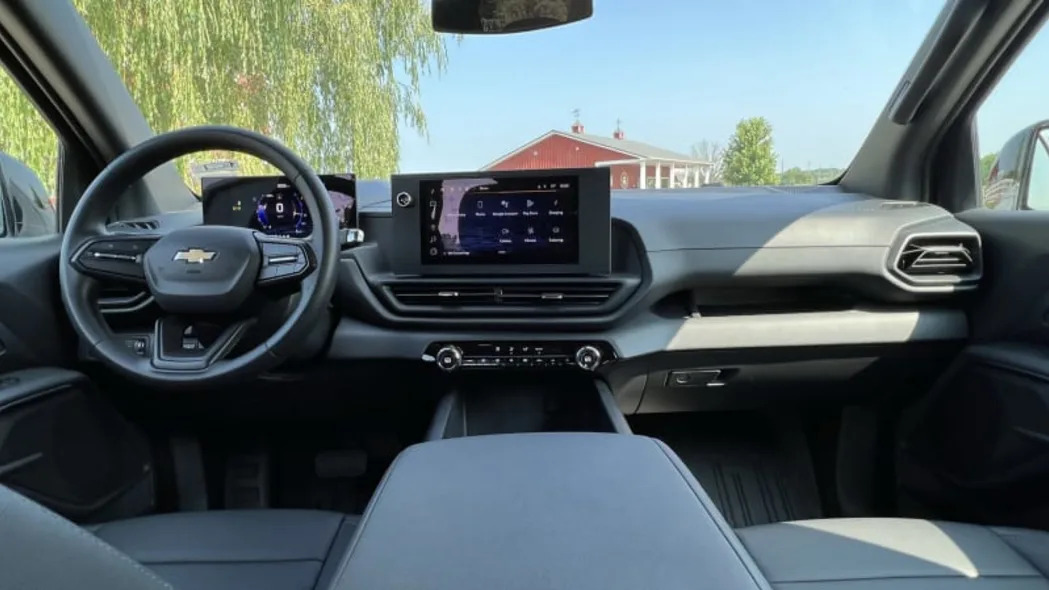
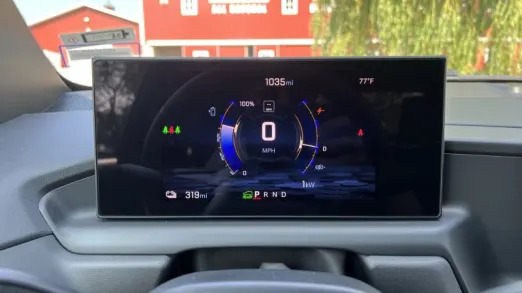
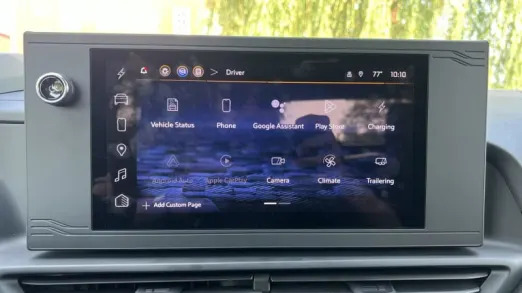
Even this work truck, though, lives in the digital world. In front of the driver is an 8-inch screen serving as an instrument cluster, while an 11-inch touchscreen serves as the central infotainment display. Yes, many functions require diving into menus, but there are physical climate control buttons below the screen, and an actual volume know right next to it. The navigation system is powered by Google, as is the voice assistant, which makes for an easy and familiar experience. We particularly enjoyed the energy information menu, which keeps track of your energy usage (and how much you’ve regenerated through braking), graphs your driving efficiency in real-time throughout your trip. This page, along with other information, can be sent to the instrument cluster by tapping the “Add to Driver Display” prompt.
The brake pedal serves as the vehicle’s ignition switch, so long as it detects the key fob inside. Similarly, you don’t need to shut the truck off; just exit. You can turn it off manually via an icon on the infotainment screen if you wish, and you can also set the cabin power to stay on while you exit — a bit like a pet mode, à la Tesla.
Heavy hustle
With 510 horsepower and 615 pound-feet of torque from its dual electric motors, the WT isn’t quite as powerful as the upcoming RST trim (754 hp and 785 lb-ft) with its Wide Open Watts mode, but do you really need to win drag races in your work truck? With that instant torque delivery, it’s still plenty of output to get four-plus tons of Silverado EV hustling down the road in short order. And, yeah, you can feel that there’s a significant amount of mass low in the truck, but the WT’s passive coil suspension works hard to keep that weight in check. It’s not the fine-tuned ride we can expect from later, fancier versions of the Silverado EV, but with its unibody-ish structure and independent rear suspension, it’s not the jouncy ride you’d get from a body-on-frame setup with a solid rear axle and leaf springs. The low center of gravity further helped control motions in the rare corners we met along our route. Steering is quite numb and artificial in its feel, but at least there’s no slop on center, and weight builds helpfully as you turn the tiller.
Of course, regenerative braking is part of the experience. The Silverado WT doesn’t have shift-style paddles on the steering wheel to adjust regen strength, nor does it have a “Regen on Demand” lever. It does, however, have two levels of one-pedal driving, kind of like the Cadillac Lyriq. In normal mode, the Silverado EV drives similarly to an internal combustion vehicle, with natural-feeling off-throttle deceleration, and even low-speed creep. You activate one-pedal driving via an icon on the infotainment screen, and there are two settings: “On” and “High.” The regular “On” setting is fairly typical for one-pedal driving. You rarely need to touch the brake pedal, but you might find yourself using it from time to time depending on the traffic around you. The “High” setting, on the other hand, is truly aggressive. Lift completely off the throttle, and your passengers will lean forward with a jolt, and you’ll stop quickly. To use it smoothly, you’ll be applying the accelerator more often than not, even when approaching a stop. It’s fun.
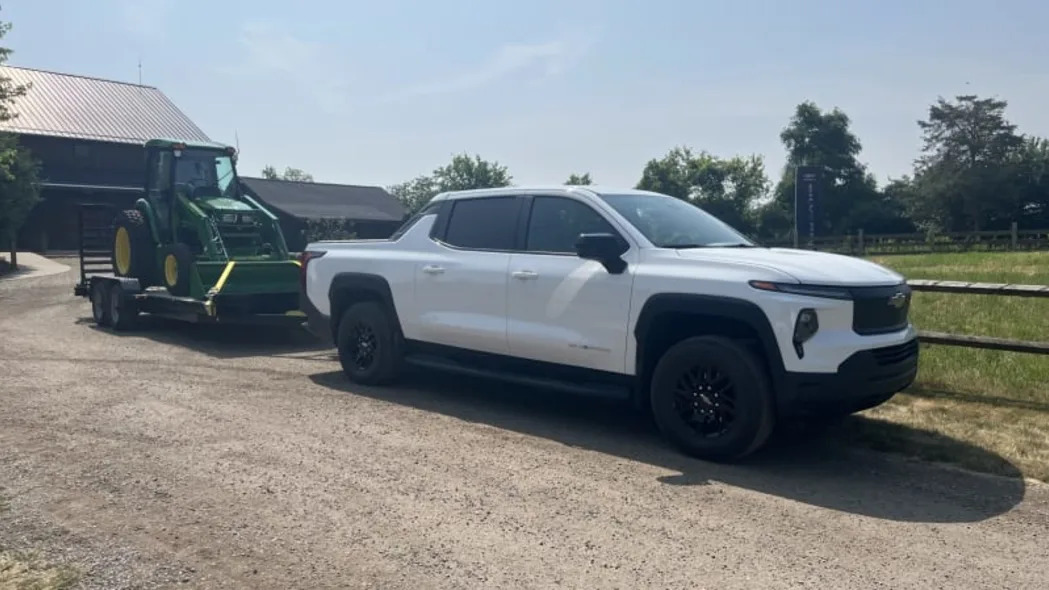
Later, we’d get a chance to tow with the WT, pulling a trailer loaded to close to the truck’s 10,000-pound capacity, on rural roads with 55-mph speed limits. It was an easy task, quite similar to our experience towing with the Lightning. The Silverado still accelerates with ease, and maneuvers without strain. We did see, unsurprisingly, our efficiency drop from our previous 2.2 miles/kWh to 1.4 miles/kWh. By our calculations, that would still give us about 287 miles of range, assuming we could maintain that efficiency beyond the 11 miles of our towing test route.
Before I arrived onsite to drive the 2024 Chevy Silverado EV WT, I had a different picture in my head of what this truck is than I do now. Not in terms of looks but in terms of capability … and price. In production form, the Silverado EV makes a good first impression. It might not look like a Silverado, it can still do truck stuff with ease and seems worthy of the name. Just as we appreciate Ford’s approach to the Lightning — take an F-150, just make it electric — we also like Chevy’s ground-up approach to electrifying its pickup space.
The market as a whole needs both tacks. But while this new Silverado EV is capable, comfortable and enjoyable to drive, even in its basic work truck form, that 450-mile EPA rating is its ace in the hole. It gives a lot of wiggle room for range-compromisers like cold weather, heavy payloads, aggressive driving and serving as a mobile power source for hours on end. Even if chargers are few and far between, this truck has the power to get the job done and get you home.
<
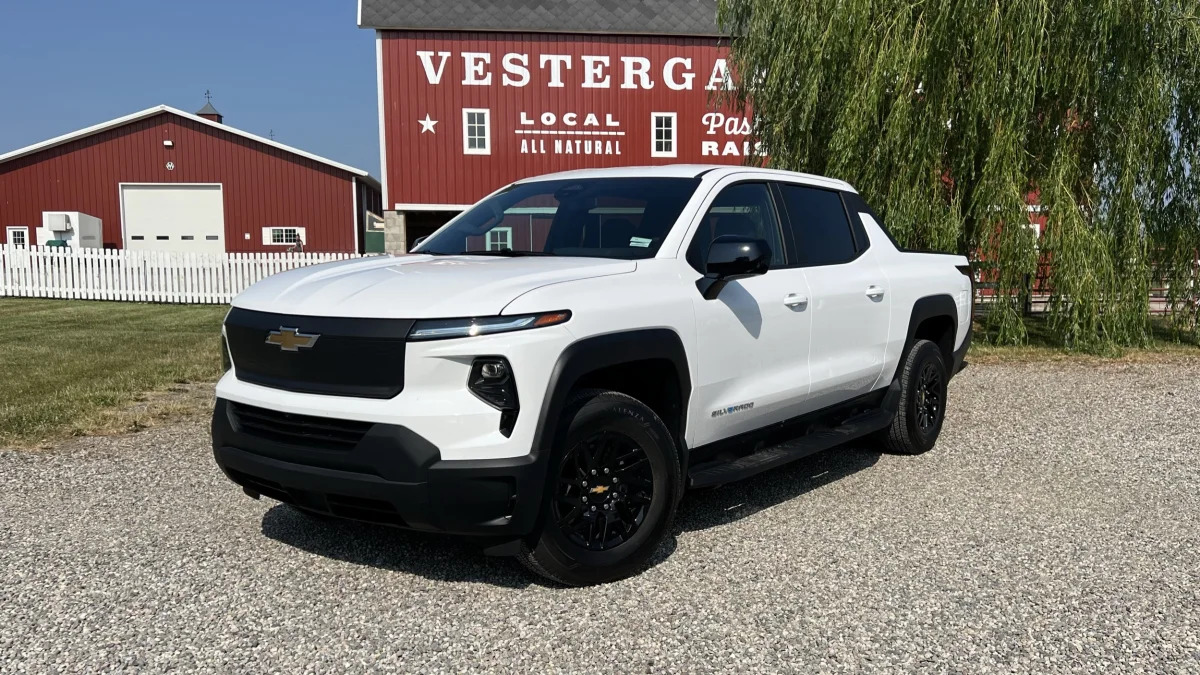









Sign in to post
Please sign in to leave a comment.
Continue